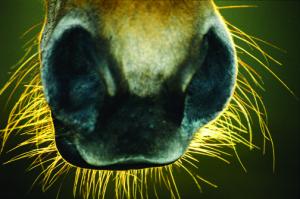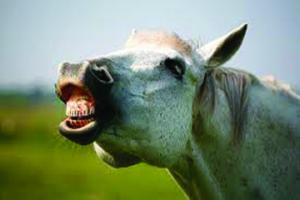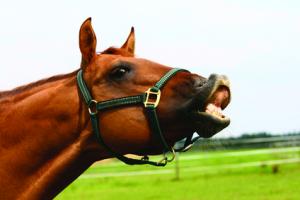By Jochen Schleese, CMS, CSFT, CSE
©Saddlefit 4 Life®2017. All Rights Reserved
Somehow our society and culture has a thing about being as hairless as possible. Women shave (or wax) as much hair off their bodies as possible in North America; men have also started waxing their chests and backs. When did hair become such an undesirable attribute? In Europe there are still many cultures that consider hair a sign of virility (for men) or beauty (in women). Wasn’t it Samson who had his hair cut off at Delilah’s request and thereby lost his strength (and ended up blind?). But now we have taken this aversion to excess hair even to our animals – specifically our horses.
The consensus seems to be that it’s acceptable to cut/shave the whiskers, the ear hair, and sometimes even the eyelashes on horses when getting ready to show. Some over-zealous owners clip frequently without a second thought. It seems timely to discuss this topic now as we gear up for show season.
This shaving really isn’t okay - for the following reasons, with thanks to Wikipedia, the International Association of Equine Behaviour Consultants, and Paul McGreavy as references. Whiskersor vibrissae are actually a type of mammalian hairthat are typically larger in size than normal hairs, have a large and well-innervated hair follicle, and have an identifiable representation in the somatosensory cortex of the brain.
The horse is a highly perceptive prey animal, and needs to rely on the information he receives from all of his senses to survive – especially the sense of touch. Horses make quick decisions with fast reactions when something unexpected touches them. The sensitivity along their sides is even greater than that of our own fingertips. Nature tends to not create superfluous items on animals, but to many people, those wiry, long hairs that protrude from around the horse’s eyelids and muzzles are considered an eyesore or a nuisance. Much as cats use their whiskers as sensory organs, the horse uses them in a variety of ways: He investigates novel objects by touching them with the vibrissae to gather more information. They act as a pre-warning device when the horse’s face or muzzle is getting close to touching an object he may want to avoid. They assist him with depth perception in the blind spot under his muzzle; even if the horse can’t see what’s literally right under his nose, he can still feel it, and make decisions based on the information he receives from touching it. Newborn foals also use them to help find the dam’s teats shortly after birth.
The horse doesn’t react when the vibrissae are trimmed, because the nerves they contain aren’t attached to pain receptors. If they did hurt, we would probably be less likely to have started trimming them in the first place. Trimming of vibrissae is outlawed in Germany, where it is understood that they play the role of sensory organ, and not just merely an untidy disruption on a clean profile. Horses that have them trimmed are more likely to suffer eye, ear, and facial injuries or lacerations, due to the lack of pre-warning they would receive when their head gets too near an object. Picture a freshly clipped horse in a trailer, who needs those whiskers to tell him when the wall of the rocking trailer is too close to his face as he bounces down the highway on the way to a show.
Horses use their lips and whiskers to explore and identify things. A horse’s brain contains cells that receive information from these whiskers. Each time the horses’ whiskers touch something, the nerves fire off an electrical impulse to the brain to help determine what it is that is being touched. Horses breathe through their noses. When a horse curls its top lip up to help in smelling something, it’s known as “Flehmen”. This happens when the nose traps pheromonal scents in the vomeronasal organs so they can be analysed more closely. Horse’s upper lips are prehensile – which means they can be used for grasping, touching or feeling something. Horses cannot see right below their noses because of the position of their eyes, which means that they use their whiskers to help them determine edible objects and stay away from hazardous ones.
If you remove these sensory organs, it is almost as though you were cutting off your fingertips. You would lose all sense of touch. I hope people will reconsider their personal vanities and do what’s right for the horse.
©Saddlefit 4 Life®2017. All Rights Reserved
Somehow our society and culture has a thing about being as hairless as possible. Women shave (or wax) as much hair off their bodies as possible in North America; men have also started waxing their chests and backs. When did hair become such an undesirable attribute? In Europe there are still many cultures that consider hair a sign of virility (for men) or beauty (in women). Wasn’t it Samson who had his hair cut off at Delilah’s request and thereby lost his strength (and ended up blind?). But now we have taken this aversion to excess hair even to our animals – specifically our horses.
The consensus seems to be that it’s acceptable to cut/shave the whiskers, the ear hair, and sometimes even the eyelashes on horses when getting ready to show. Some over-zealous owners clip frequently without a second thought. It seems timely to discuss this topic now as we gear up for show season.
This shaving really isn’t okay - for the following reasons, with thanks to Wikipedia, the International Association of Equine Behaviour Consultants, and Paul McGreavy as references. Whiskersor vibrissae are actually a type of mammalian hairthat are typically larger in size than normal hairs, have a large and well-innervated hair follicle, and have an identifiable representation in the somatosensory cortex of the brain.
The horse is a highly perceptive prey animal, and needs to rely on the information he receives from all of his senses to survive – especially the sense of touch. Horses make quick decisions with fast reactions when something unexpected touches them. The sensitivity along their sides is even greater than that of our own fingertips. Nature tends to not create superfluous items on animals, but to many people, those wiry, long hairs that protrude from around the horse’s eyelids and muzzles are considered an eyesore or a nuisance. Much as cats use their whiskers as sensory organs, the horse uses them in a variety of ways: He investigates novel objects by touching them with the vibrissae to gather more information. They act as a pre-warning device when the horse’s face or muzzle is getting close to touching an object he may want to avoid. They assist him with depth perception in the blind spot under his muzzle; even if the horse can’t see what’s literally right under his nose, he can still feel it, and make decisions based on the information he receives from touching it. Newborn foals also use them to help find the dam’s teats shortly after birth.
The horse doesn’t react when the vibrissae are trimmed, because the nerves they contain aren’t attached to pain receptors. If they did hurt, we would probably be less likely to have started trimming them in the first place. Trimming of vibrissae is outlawed in Germany, where it is understood that they play the role of sensory organ, and not just merely an untidy disruption on a clean profile. Horses that have them trimmed are more likely to suffer eye, ear, and facial injuries or lacerations, due to the lack of pre-warning they would receive when their head gets too near an object. Picture a freshly clipped horse in a trailer, who needs those whiskers to tell him when the wall of the rocking trailer is too close to his face as he bounces down the highway on the way to a show.
Horses use their lips and whiskers to explore and identify things. A horse’s brain contains cells that receive information from these whiskers. Each time the horses’ whiskers touch something, the nerves fire off an electrical impulse to the brain to help determine what it is that is being touched. Horses breathe through their noses. When a horse curls its top lip up to help in smelling something, it’s known as “Flehmen”. This happens when the nose traps pheromonal scents in the vomeronasal organs so they can be analysed more closely. Horse’s upper lips are prehensile – which means they can be used for grasping, touching or feeling something. Horses cannot see right below their noses because of the position of their eyes, which means that they use their whiskers to help them determine edible objects and stay away from hazardous ones.
If you remove these sensory organs, it is almost as though you were cutting off your fingertips. You would lose all sense of touch. I hope people will reconsider their personal vanities and do what’s right for the horse.











